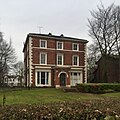
John Dalton was an English chemist, physicist and meteorologist. He introduced the atomic theory into chemistry. He also researched colour blindness; as a result, the umbrella term for red-green congenital colour blindness disorders is Daltonism in several languages.

Regent's Park College is a permanent private hall of the University of Oxford, situated in central Oxford, just off St Giles', England, United Kingdom.
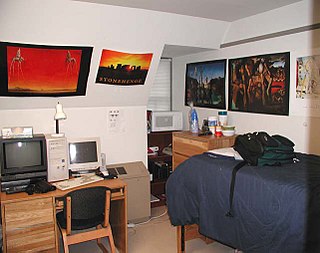
A dormitory, also known as a hall of residence or a residence hall, is a building primarily providing sleeping and residential quarters for large numbers of people such as boarding school, high school, college or university students. In some countries, it can also refer to a room containing several beds accommodating people.

Owens Park was a large hall of residence located in the Fallowfield district of the city of Manchester, England. The site is owned by the University of Manchester and housed 1,056 students. Owens Park is a significant part of the Fallowfield Campus of the University of Manchester. The terms 'Owens Park' and 'Fallowfield Campus' are sometimes used interchangeably. The first phase was completed in 1964 and the second in 1965.

Victoria Park is a suburban area of Manchester, England. Victoria Park lies approximately two miles south of Manchester city centre, between Rusholme and Longsight.
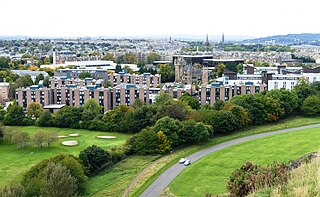
Pollock Halls of Residence is the largest halls of residence for the University of Edinburgh, located in St Leonard's, Edinburgh, Scotland, near the foot of Arthur's Seat. The complex of buildings houses more than 2,000 undergraduate students during term time, and is available to the public as bed and breakfast-style accommodation outside of the teaching term. While some of the buildings date from the 19th century, the majority of Pollock Halls dates from the 1960s and early 2000s. Pollock Halls are located on the edge of Holyrood Park, 1+1⁄4 miles (2.0 km) southeast of the centre of Edinburgh, and 3⁄4 mile (1.2 km) from the university's central area around George Square.
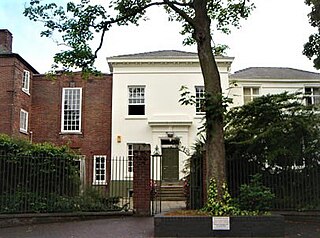
St Anselm Hall, known colloquially as Selms, is a traditional University of Manchester hall of residence situated in Victoria Park.
Dalton Hall might refer to:

Deans Court is a student hall of residence at the University of St Andrews originating from the 12th century, thus, arguably, the oldest dwelling house in the town of St Andrews, Scotland. It stands at the east-end of St Andrews, where North street and South street converge. The entrance of the courtyard opens up to the ancient, ruined, St Andrews cathedral. The Hall is open exclusively to postgraduates, and comprises the main building and four annexes, two on North Street, two on South Street. Current residents are affectionately known as Deans Courtiers, Deans Courtesans, or Deans Beans.

Uttley House, is a Grade II listed building and halls of residence in Fallowfield, Manchester, England. It was designed and built in 1850 by Edward Walters, who was also responsible for Manchester's Free Trade Hall. The building is named after English writer Alison Uttley. It was originally built for Sir Joseph Whitworth; the house was later the home of C. P. Scott, editor of the Manchester Guardian. It is surrounded by 5.5 acres (2.2 ha) of gardens to the south and an environmental research institute to the north. The house has seen many past uses, including a private home, hotel, vaccination clinic and conference centre.

The upper campus residence halls at the University of Pittsburgh include Sutherland Hall, Panther Hall, K. Leroy Irvis Hall, the fraternity housing complex, and the Darragh Street Apartments. Among the newest residence facilities at the university, these buildings reside on the upper campus located near many of the school's athletic facilities. The upper campus resides approximately 200 feet (61 m) above the lower campus that lies along Forbes and Fifth Avenues, providing dramatic views along the hilltop and slopes. Planning for upper campus student housing originated in the late 1960s and early 1970s, but stalled due to community and political opposition until the early 1990s with the opening of Sutherland Hall, the first major student residence constructed by Pitt in 29 years.

Saint Chrysostom's Church is the parish church in Victoria Park, Manchester, England. The church is of the Anglo-Catholic tradition, and also has a strong tradition of being inclusive and welcoming.
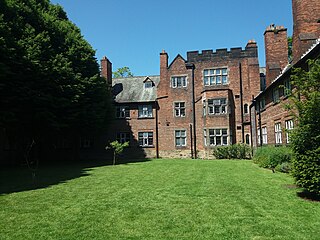
Hulme Hall is a traditional University of Manchester hall of residence situated at the Victoria Park Campus in Rusholme, Manchester, housing 300 students. It has a range of facilities including the John Hartshorne Centre: a 300 seat lecture theatre with attached seminar rooms; a library; Junior Common Room and study spaces; music room; old dining hall; the Victoria Park bar; and chapel.

Ashburne Hall is a University of Manchester hall of residence for students on the Fallowfield Campus, situated 2 miles (3.2 km) south of the main university campus. The hall has catered accommodation offered to mainly undergraduate students, though some places are reserved for postgraduate students.
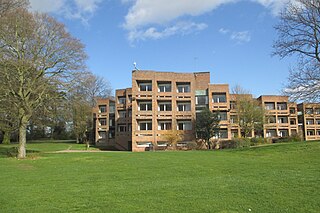
The Lawns is a former student accommodation complex for the University of Hull, located in Cottingham, East Riding of Yorkshire, England. It comprised seven halls of residence and the Lawns Centre. The latter was the complex's catering and social hub. The halls accommodated almost 1,000 students. With the exception of the older Ferens Hall, The Lawns was built in the 1960s to the designs of architectural firm Gillespie, Kidd and Coia. The halls are Grade II* listed buildings, though the site was closed as student accommodation at the end of the 2018/2019 academic year.

The Reform Club in Manchester, England, is a former gentlemen's club dating from the Victorian era. Built in 1870–1871 in the Venetian Gothic style, it was designed by Edward Salomons, in collaboration with an Irish architect, John Philpot Jones. The building is situated on the corner of King Street and Spring Gardens. Claire Hartwell, in her Manchester Pevsner City Guide considers the club Salomons' "best city-centre building" and it has a Grade II* heritage designation. The contract for construction was awarded to Mr Nield, a Manchester builder, and had a value of £20,000. The Reform was constructed as the club house for Manchester's Liberal Party, and was opened by Granville Leveson-Gower, 2nd Earl Granville, Liberal Foreign Secretary, on 19 October 1871.
George Tunstal Redmayne, more usually G T Redmayne, was the youngest of four sons of Giles Redmayne and his wife, Margareta Robey. He was born in London and attended Tonbridge School for two years before being educated by private tutors. His father was a wealthy linen draper and silk mercer who owned a house in London and Brathay Hall in the Lake District where he employed architect Alfred Waterhouse in the mid-1850s. George Redmayne became Waterhouse's pupil in 1859 and remained with him as his assistant. He married Waterhouse's sister, Katherine, in 1870 and they had two sons, Martin, in 1871, and Leonard, in 1877. Redmayne died at his residence, Great Stoakley in Haselmere, in 1912.

TAFE Hall of Residence is a heritage-listed disused residential college at 95–107 Musk Avenue, Kelvin Grove, City of Brisbane, Queensland, Australia. It was designed by John Dalton and built from 1976 to 1978. It was added to the Queensland Heritage Register on 25 February 2004.
Manchester is a city in Northwest England. The M14 postcode area is to the south of the city centre, and contains the areas of Fallowfield, Moss Side, and Rusholme. The postcode area contains 59 listed buildings that are recorded in the National Heritage List for England. Of these, one is listed at Grade I, the highest of the three grades, three are at Grade II*, the middle grade, and the others are at Grade II, the lowest grade.
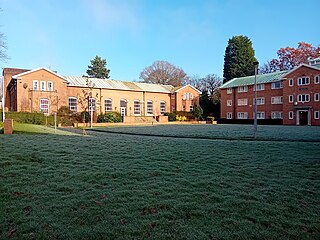
Woolton Hall is a traditional University of Manchester hall of residence situated within the Fallowfield Campus complex. Established in 1959 as a male-only hall it was the last traditional catered hall of residence founded as part of the University of Manchester, during a period of ambitious residential expansion for the university. Along with Hulme Hall, Dalton-Ellis Hall, Ashburne Hall, and St. Anselm Hall, Woolton is one of the five remaining traditional collegiate halls of residence at the University of Manchester. The hall is catered and contains a Junior Common Room.



